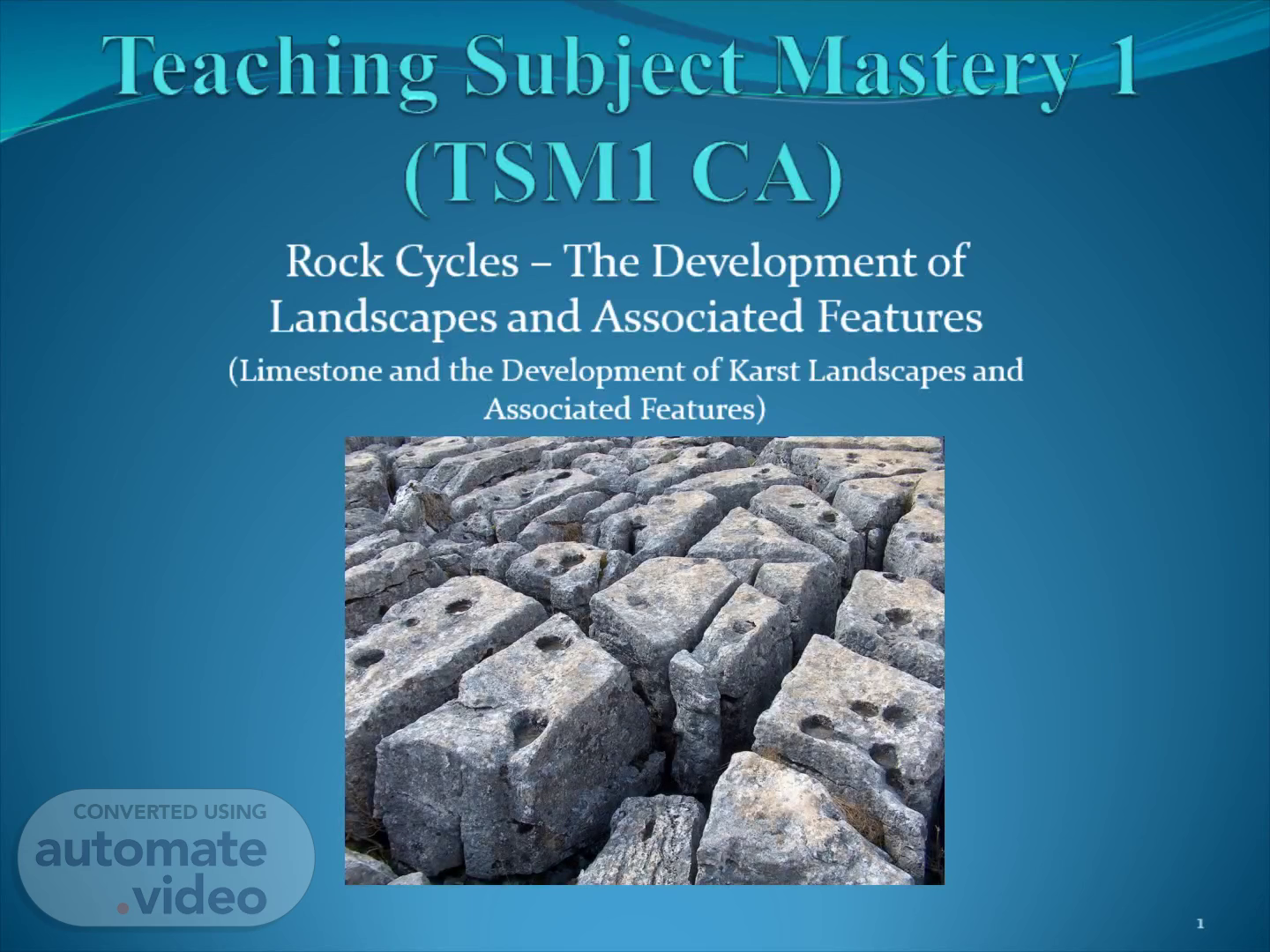
Teaching Subject Mastery 1 (TSM1 CA)
Scene 1 (0s)
Teaching Subject Mastery 1 (TSM1 CA). Rock Cycles – The Development of Landscapes and Associated Features (Limestone and the Development of Karst Landscapes and Associated Features).
Scene 2 (12s)
My Rational for choosing this topic. My rationale for choosing this topic is that as a student of Geography in Junior Cycle, Senior Cycle and Undergraduate level in university, I struggled with many different concepts of Physical Geography, in particular, Rock Types and Landforms and features that are associated with each different Rock Type..
Scene 3 (31s)
Place in the Curriculum. Rock Cycles – The Development of Landscapes and Associated Features can be found in the Core Unit 1 “Patterns and Processes in the Physical Environment” in area 1.4 named “ Landform Development” (ii)” whereby, “The development of landforms is influenced by rock characteristics which have resulted from the operation of the rock cycle”. In this area of the Leaving Certificate Curriculum, students should study ( i ) landforms associated with particular rock types and (ii) the way in which spatial variations in rock types may influence the physical landscape. Like in all topics in Geography, examples should be taught and learned on both a National Setting and an International Setting..
Scene 4 (1m 0s)
Brief Overview of Topic (R ock Cycles (Limestone) and The Development of Landscapes (Karst) and Associated Features).
Scene 5 (1m 42s)
What year group will be studying this topic?. This topic is taught in 5 th year according to the “Guidelines for Teachers” published by the NCCA (National Council for Curriculum and Assessment)..
Scene 6 (1m 55s)
What do you want your students to learn about this topic and its importance?.
Scene 7 (2m 27s)
What prior knowledge will students have of the topic?.
Scene 8 (2m 45s)
What concepts may be difficult for students to grasp.
Scene 9 (3m 9s)
What would happen during the beginning, middle and conclusion of an introductory lesson on this topic?.
Scene 10 (3m 34s)
(Cornell Note Taking). The purpose of this strategy as a teacher is to alert students to self-question when they read as well as determine the important of the content they are analysing. This strategy allows students to develop a system in which they can organise information and data into an easy and useful format Students identify the key points and important information of the topic, by recording the key points in the first column and the essential details in a second column . Beneath these columns, students will then record small key points to summarise the main ideas of the topic. These notes will then act as a study guide for students for when they reflect on the topic..
Scene 11 (4m 5s)
Conclusion. Whilst every topic should open with a “warm up” activity to trigger students prior knowledge of a topic, it is important that they also finish with a “cool down” activity During this cooling down activity, it is pivotal that your class is “cooled down” by discussing any challenging or difficult areas of the topic in question It is essential that this time is used to answer any questions or explain anything that students may have had a challenging time with. Crucially, it is the teachers responsibility that students leave the classroom with more clarity of the topic and therefore less confusion about the topic covered in the lesson..
Scene 12 (4m 33s)
. What specific teaching, learning and assessment strategies will be particularly useful in teaching this topic?.
Scene 13 (5m 4s)
What are the Key Skills and how will they be developed?.
Scene 14 (5m 31s)
14. Being Literate Managing Information & Thinking: Being Numerate: Being Creative: Teamwork: Communication: ICT (Information and Communications Technology) Skills.
Scene 15 (5m 42s)
What cross-curricular links can be made with other subject disciplines?.
Scene 16 (5m 53s)
References. Knight, Peter G. (2007) “Physical Geography: Learning and teaching in a discipline so dynamic that textbooks cant keep up!”, Education Matters, 92(1), pp. 57-58. [Online] Available at: https://www.jstor.org/stable/40574308 (Accessed:14/10/2021) Leeder , Andy, (2006) “100 Ideas for Teaching Geography”, pp. 12-19, 22-39, 66-71. [Online] Available at: https://eds.p.ebscohost.com/eds/ebookviewer/ebook/bmxlYmtfXzM3ODA0N19fQU41?sid=4c7d0087-d4e2-4fbc-ba0e-98fb54cd05ae@redis&vid=0&format=EB&rid=2 (Accessed: 14/10/2021) National Council for Curriculum and Assessment (NCCA) (2017) Junior Cycle Geography. [Online] Available at https://www.curriculumonline.ie/getmedia/2a7a8d03-00e6-4980-bf20-f58def95688f/JC_Geography-en.pdf (Accessed: 12/10/2021) National Council for Curriculum and Assessment (NCCA) (2003) Senior Cycle Geography. [Online] Available at https://www.curriculumonline.ie/getmedia/9da21be1-3f99-4f50-88ee-ba7ce6638e1a/SCSEC17_Geography_syllabus_eng.pdf (Accessed: 12/10/2021) National Council for Curriculum and Assessment (NCCA) (2004) Guidelines for Teachers. [Online] Available at https://curriculumonline.ie/getmedia/e7c30be5-df65-4d0b-8377-7bed94697978/SCSEC17_Geography_guidelines_eng.pdf (Accessed 16/10/2021) Fitzgerald, Declan and White, P.J. (2019) Landscapes. Gill. Rafferty, John P. (2019) Karst Geology. Available at https://www.britannica.com/science/karst-geology (Accessed: 16/10/2021) Geological Survey (2020). The Rock Cycle. Available at https://www.gsi.ie/en-ie/education/rocks-minerals-and-gems/Pages/The-rock-cycle.aspx (Accessed: 18/10/2021) Carmichael, Cady Prof. (2020). Physical Geography. [Online] Available at: https://docs.google.com/document/d/1KHLKrP9tn7A5aiHT1fGUBfsStCdWZRI45ZFq6yyrGzg/edit (Accessed: 20/10/2021) Katupotha , Jinadasa . (2015). Geography Subject. [Online] Available at: file:///C:/Users/Rob%20Abbott/Downloads/GEOGRAPHYSUBJECT2004.pdf (Accessed: 20/10/2021) Ordnance Survey Ireland (OSI). (2021). Geology Rocks: Ireland’s Best Rock Formations. Available at: https://osi.ie/blog/irelands-rock-formations/ ( Accessed:18/10/2021).